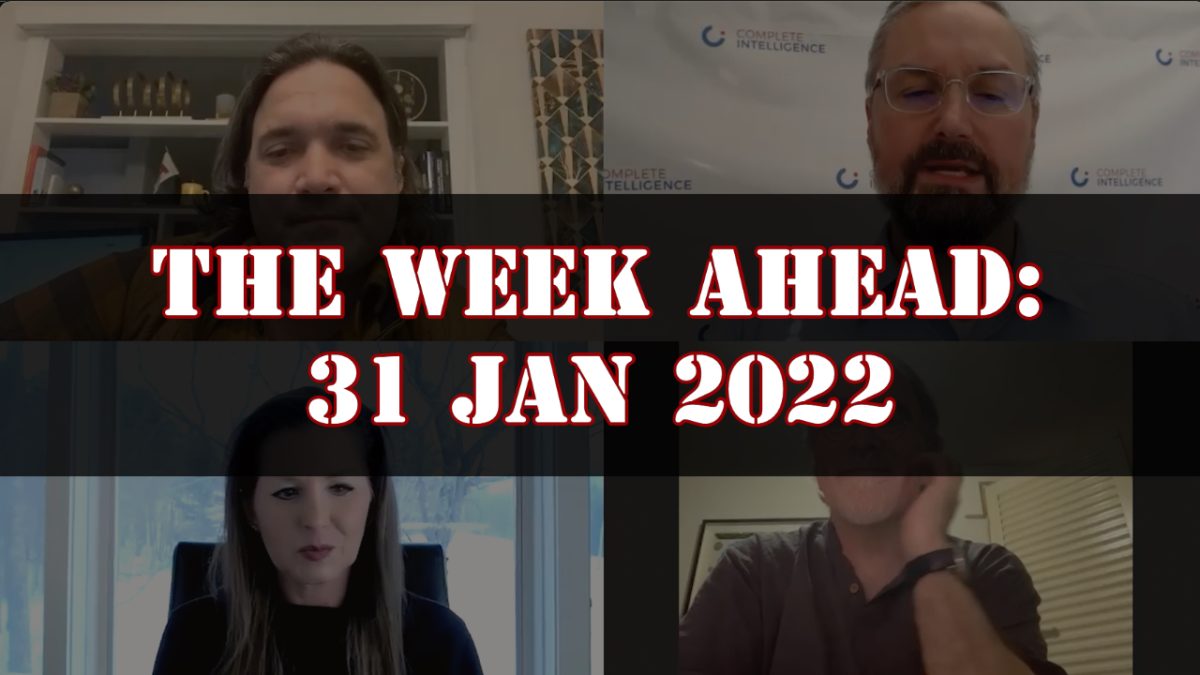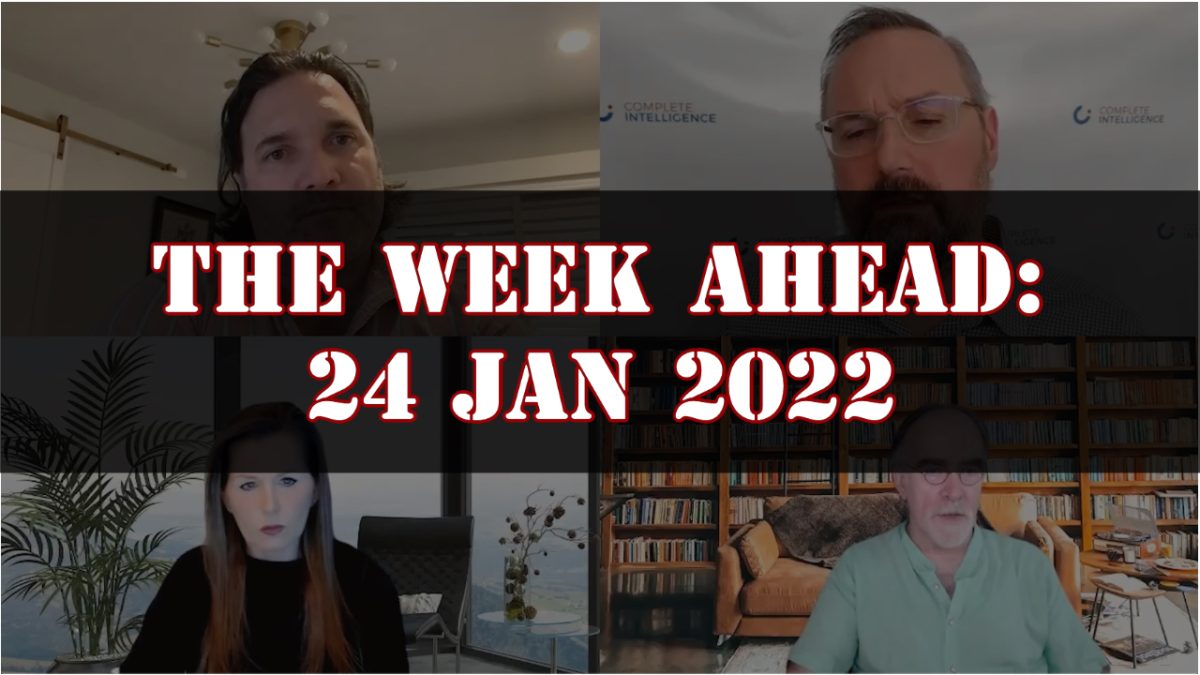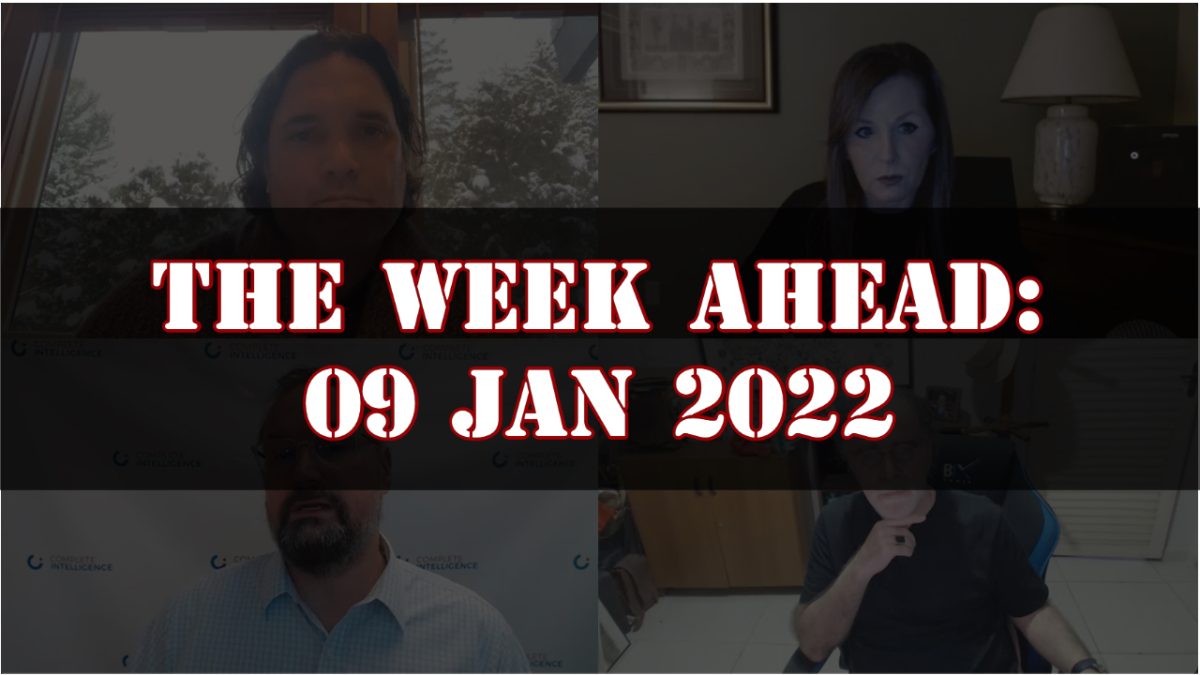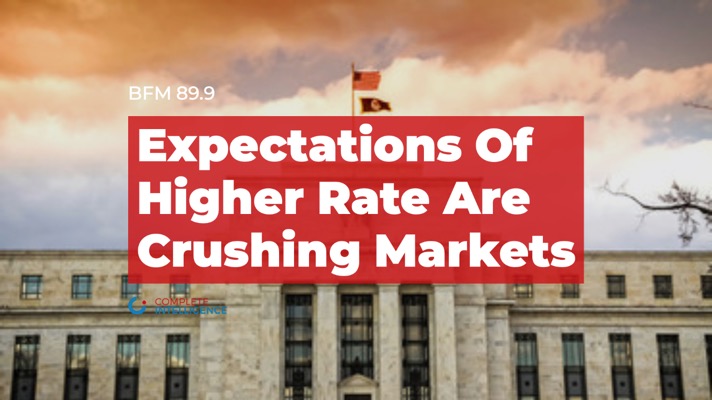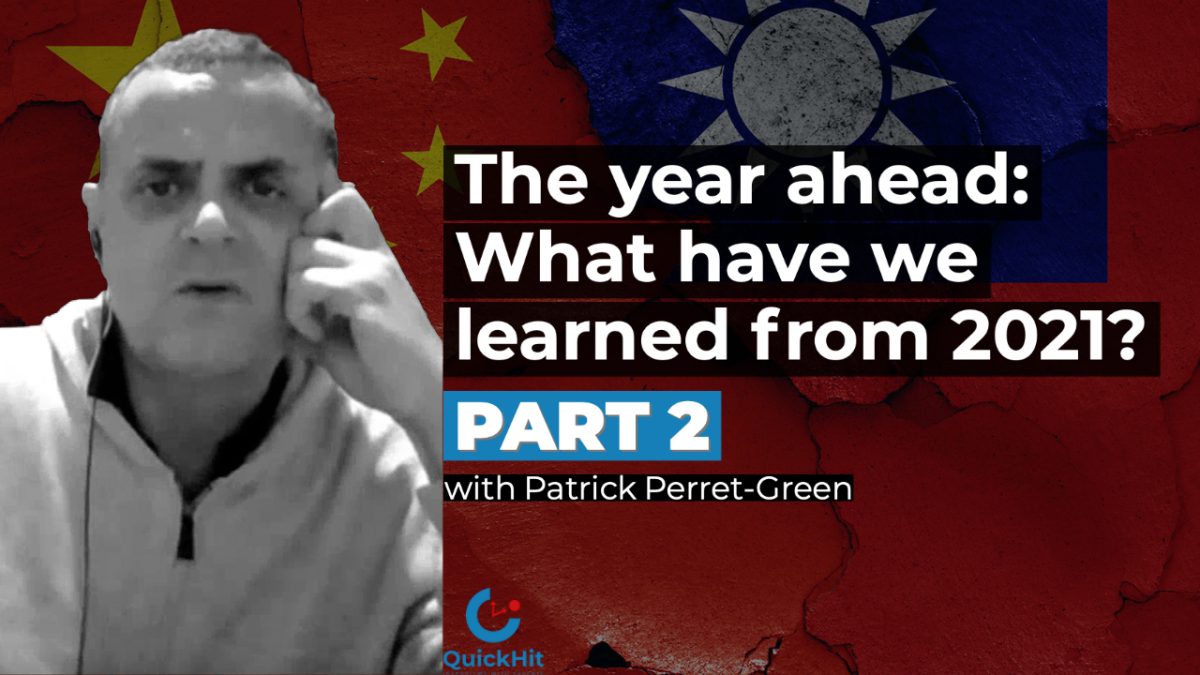We’re dissecting Jerome Powell’s latest announcement — what does that mean to markets this coming week? Will we see Powell’s inner Volcker this year? What are we expecting to happen in the energy markets considering the geopolitical risks in Russia and Ukraine? Has the White House and Treasury told the Fed to fight inflation as its top priority?
This is the fourth episode of The Week Ahead in collaboration of Complete Intelligence with Intelligence Quarterly, where experts talk about the week that just happened and what will most likely happen in the coming week.
Follow The Week Ahead experts on Twitter:
Tony: https://twitter.com/TonyNashNerd
Tracy: https://twitter.com/chigrl
Nick: https://twitter.com/nglinsman/
Albert: https://twitter.com/amlivemon
Show Notes
TN: Hi, everyone, and welcome to The Week Ahead. I’m Tony Nash. And I’m joined by Nick Glinsman, Albert Marko, and Tracy Shuchart. Before we get started, I’d like to ask you to subscribe to our YouTube channel. It helps us with visibility, helps you get reminded of our new episode. So please do that.
While you’re thinking about it, this week was all about the Fed. Of course, we expected Monday and Tuesday to be choppy. We told you that on our last Week Ahead, which they were. We talked about it last week. We talked about the said meeting last week. And as Wednesday got closer, it appeared that Powell would be more bearish. And that seems to be exactly what we got.
So today we’d love to focus on a few things. Nick, let’s start with you. What were your main takeaways from the Fed?
NG: Okay, I’ve got three takeaways, most of which came after the Fed. Okay. The statement was sort of bland, almost appalling in terms of, it felt like it was leaving the risk markets to determine the Fed’s policy. And then, boy, Powell come out hawkish. He refused to give any direct answers but never denied any of the points and the questions such as how many rates, how many it takes?
So what was interesting is today, we had the first Fed Speaker, Neil Kashkari, the Uberdam for the FOMC.
TN: That’s right.
NG: And he basically came out and said whatever it takes, we’ve got to get inflation. I mean, shocking. Now where Powell got confirmed in his hawkishness came today with the ECI data. The base figure was slightly less than expected. But lift the bedsheets up and you are seeing major wage pressures.
If you look at some of the increases in wages and salaries, four and a half percent for all civilian workers, 5% for private sector workers, up from 4.2 and 4.6% respectively. If you go deeper, hospitality, health care, you’re looking at 7% and 8% increases.
TN: Nurses in many cases are making as much as doctors now in a number of cases.
NG: Exactly. So that basically confirmed Powell’s words of a rapid pace of wage grip. Okay. And I think that was a very key piece of data, which in fact, a Bongi like me would have been waiting for. Right now.
TN: We don’t see them bonds today, did we?
NG: What’s that?
TN: We didn’t see the action in bonds today, did we?
NG: They were down initially and then after the day, they rallied a bit. But I think that was more to do with reversing a very successful week of your well positioned. And what’s interesting, though, this came after that hawkish press conference. So typically what you have is the yoke of mutually reinforces the relationship with the Fed’s monetary policy. So simplistically, when an economy is strong and in danger of overheating, you are going to see the yield curve steeper. Long end, higher rates relative to the short end.
Now that then reflects that the rates have to rise, that’s the historical perspective. What was interesting this time was the curve was bare flat, and it was headed towards an inversion, the consensus. That’s a really bad signal of an approaching recession.
What it’s basically suggesting at that point, historically, the bond market tends to suggest Fed’s tighten too much. We’re going to get a recession. It needs to stop. Reassess, perhaps even cut. So what’s startling about this whole move is you got yield curve flat, bear flattening, coming so soon before the Fed has even started raising rates.
TN: Right.
NG: So if you have a Swift move to inversion, it’s going to be slightly, somewhat harder for the Fed to carry out its hiking program over time. That tells me that you’re going to have it front loaded. It also suggests to me, which is what you got from Powell’s press conference, it may not be 25 basis points each hike. It may be 350s. Right. Especially with this inflation.
He was all about inflation risks to the upside and a very strong labor market.
TN: 350 basis point hikes. I just want to make sure we make sure that we know what you said.
NG: Yes. Basically the Yoker is suggesting that. But some of his comments were this is a labor market that’s rocketing. This is inflation that still has risk. The upside. We saw a bit of that today. He also said supply chains are not going to get resolved this year. We’re going to have to wait till next year.
TN: Okay. Let’s stop there, because I want to ask you something, and this may be an overly simplistic way of asking the question and Albert and Tracy jump in here.
But it seems to me that kind of what he’s saying indirectly is, hey, there are supply side inflation, okay. And we as the Fed can’t control the supply side, we can only control the demand side to some extent. And so what we’re going to do is we’re going to put a stopper on demand so that demand can come down to match up with the available supply. And that’s how we’re going to we don’t have the tools to put the kibosh on the supply side inflation. So we’re going to bring the demand down.
First of all, does that seem to be what he’s saying?
NG: I think that’s probably what he’s trying to say. I would add one other point. So we were all thinking that after the big rise in crude oil and energy prices last year, we would get some beneficial payback by the comparison, but we’re not oil still going up, so we’re not getting that.
And the most extreme version is, for example, Europe. These have all got to feed through from wholesale to retail.
AM: Yeah.
NG: I think it was 95% of surveyed American CEOs. I can’t remember the sort of survey, but I can dig it out. Are expecting to raise prices.
AM: Yeah. The problem with them trying to limit demand, though, is it’s going to start affecting jobs. Labor market’s certainly going to weaken if demand starts to fall off. Because wage inflation is going nowhere. I’ll tell you that right now. Wage inflation is here to stay politically is absolutely just not going to ever come back down. So that’s going to be sticky for quite a while.
NG: But I think Powell was implying that where he basically said the labor market is super strong. So I don’t disagree with it will dampen it. The question is whether it turns around.
Remember, we’re getting all these people retiring and dropping out. Yes, that was your data, Albert.
TS: He kept reiterating the labor market is super strong. But the labor market really, if you look under the hood of it, it’s not really super strong. We all know that.
TN: That’s true.
NG: Yeah. Agreed. But it’s perceptions. Remember, these guys are basing their work off their forecasts. One of their forecasts have ever been right. Okay. Even worse in Europe. So the point I’m making is they have their parameters. They have the data that they look at and monitor and whether we agree with that data or not. And I mean, I would always disagree with the way the Fed measures, the BLS measures CPI, but it was impacted by Arthur Burns of the Fed in 1970s. Right.
So the point to be made is they have their data sets that they watch, and according to those data sets, they may be wrong. I don’t disagree.
TN: So just yes or no, because you’re implying some things that two weeks ago we talked about or last week we talked about, yes or no. Will we see J. Powell’s innver Volcker this year?
NG: Yes.
TN: We will?
NG: In the short term.
TN: Albert, what do you think? Yes or no? Will we see J. Powell’s inner Volcker?
NG: Mini Volcker.
AM: Mini Volcker, I agree with. One and done Volcker, a one week Volcker, yes, I agree with.
NG: If he does the one and done, the bond market will riot. If you look at the Fed meeting. But look at the statement. That statement said, basically risk assets will determine the level of Fed funds, right?
AM: Yeah.
NG: Bond market’s sold off. Hold on. The bond market’s sold off, aggressively. Sold off all across the curve and particularly the long end. It didn’t start to flatten in a bare manner until that press conference.
TN: Sorry, guys, let me stop you both just for a second. Tracy, will J. Powell show his inner mini Volcker this year?
TS: I said this last week. I’m in the one and done camp, maybe two, but I’m cutting it out there. I know Bank of America came out today and said seven. They said the “seven” yes, today, which I think I don’t know what they’re smoking exactly. But I’ll go with max two on this one, even though I said one and done. I’ll stretch that out.
Maybe one more, but that’s where I stand on that one.
TN: Okay. So while we’re with you, Tracy, can you give us a quick view on what did markets get right and wrong this week from your perspective? What do you think is a little bit out of whack?
TS: Well, I mean, I think energy markets obviously remain elevated because of the Russia-Ukraine risk, right? Because Russia’s 10 million barrels per day, they produce a lot of gas. That’s here with us to say we have a northeastern so that kept a bid under at least the energy markets, right. I think last week we were talking about continued volatility all around in, say, the indices and obviously that trend is continued and probably likely will continue into next week.
Again, looking ahead to next week, I expect that probably we’ll still keep a bid under oil, but we did go kind of sideways this week. Even though we got new highs, I still think we’ll stay in that $82 to $87 range, probably for the next week or so, and then probably get a little bit. If nothing happens with Russian and Ukraine, we’ll get a little bit of pullback there. But still looking at the overall fundamentals of the market, they remain very strong. So I don’t think we’ll see any kind of material.
TN: Okay. This is on the commodity side. On the commodity side. Okay. What about the equity side?
TS: Well, it’s. Far as equities indices are concerned, I think that we’re again going to see continued volatility. What I think is very interesting. As long as the market is pricing in rate hikes, that’s going to put pressure on growth versus value. Right.
And so I think that trend will continue. I think we’re in for a rough note. Until that March meeting, until we actually hear an actual decision, we could be setting up for another volatile month in February.
TN: Okay. That’s fun. Right. Okay. So let’s take that and let’s swing over to geopolitics for a minute. And Albert, I want to ask you a couple of things about geopolitics. Tracy mentioned Kazakhstan, which we’ll get to in a minute. But has the White House told the Fed and treasury that inflation is a top priority? Is that what you’re hearing out of DC? Are they getting political pressure to make inflation their top priority?
AM: Oh, absolutely. Inflation is a nuclear bomb for politicians. I mean, gas prices rising, food prices rising. The job market is they can say it’s strong, but it’s not. I mean, realistically talking about 15%, 20% unemployment, so it’s not strong. So, yeah, inflation is absolutely priority number one for the next couple of months.
TN: Right. Okay. And then as we move into a little bit more on geopolitics, so we got a viewer question from at 77, Psycho Economics. He says, has Russia’s stabilization of Kazakhstan increased their influence over energy exports to Europe?
So give us a little bit of kind of overview of what you see happening in Kazakhstan. And then if you and Tracy can help us understand what’s happening with the energy exports to Europe, that would be really helpful.
AM: Yeah. Kazakhstan has been stuck between Russia and China for a couple of years now. But realistically, that’s Russia’s backyard. They control the area. Ever since the United States was booted out of Uzbekistan, they’ve lost a lot of sway in the region. So the energy sector from Kazakhstan all the way to Turkey and into the Mediterranean is pretty well dominated by the Russians right now.
TS: And I would agree with that. I would also like to mention just as an energy producer, I mean, Kazakhstan doesn’t produce all that much.
So if you’re looking at the commodity side, I would say Ukraine would have more of a dent because of how much they’re involved in the cereals markets. How much do they export in the cereals markets, how much they export in the uranium market. So that’s definitely more commodities heavy area that I would be concerned about then Kazakhstan, just from the energy standpoint.
AM: Yeah. And when you’re looking at Russia and talking about energy, it’s not necessarily you don’t single out just Russia’s energy production. They go out and they meddle everywhere they possibly can, whether it be Libya, Kazakhstan, Turkey, everywhere they can to sit there and depress those energy exports so they can pump out there. So that’s what I mean by Russian dominance in the sectors. Sure.
NG: Will Russia attack the Ukraine?
AM: You’re looking at maybe 1020 thousand conscripts that Russia probably hasn’t paid in a while to go and loot the countryside of Ukraine where it’s already Russian dominated speakers.
Biden comes out and talks about sacking Kiev as if it’s Hannibal on the gates of Rome. This is just absurdity. Russia has no military, nor does he want to go into Kiev and hold it. What’s the point of bombing the thing? Of course, they can go in and destroy Kia if they wanted to overnight, but that serves absolutely zero purpose. So are they going to invade? Yeah. I mean, I would give it a 60 70% chance, but would it be something some big kind of issue at. No, the market is looking at this issue as World War II. And it’s just nothing more than a little bit of a skirmish that’s kind of kinetic.
TN: But they’ve already invaded the economy. They’ve already invaded any investors who want to go into Ukraine, that nobody’s going to touch Ukraine for at least the next year. Right.
AM: Well, Tony, listen, I’ve been to that region, worked there for years in Georgia and Ukraine. I mean, Ukraine has corruption issues, of course, aside from the Russian problem. Right. They’ve got legal framework problems and corruption problems that it makes investing there quite difficult.
TN: Right. Okay, so you’re saying no, not going to happen. You’re saying maybe some looting in Eastern Ukraine.
AM: But they’ll reinvent the same areas that they did in 2014. They’ll make Biden and the west look inept, and that’s their goal. That’s it.
TN: Great. Okay. Sounds fun. As we look ahead, what milestones are you looking for? The week ahead, Nick, what are you expecting to see next week in markets?
NG: I’m fascinated to see the next bunch of Fed speakers come out. If we had the Uber Dove, very hawkish. That’s as hawkish as he’s ever spoken, Kashkari. I’m fascinated to see what the others are going to say.
What I can’t get a handle on is whether this is a genuine bear market inversion or flattening going on the bomb market. I still maintain the point that you’ve got to look at the market and watch what’s going on. Okay.
So I’ll be interested to see whether that continues. If it doesn’t continue, that tells me that it was actually a bit half partly people reversing bad positions on the Euro curve because really traditionally we should be having your curve deepening.
And then next week, well, we’ve got unemployment coming out on the Friday, so that’s going to be pretty fascinating. And then we’ll have the following week, all that inflation data starting to come through, and we won’t have the favorable comparisons from a year ago.
The banks have all jumped on like Tracy said, bank of America seven hikes. Goldman is four to five hikes. They are jumping on this. This did surprise the banking community, with maybe the exception of Goldman, who came out beforehand and said this is what I was thinking. So it’s a pull and push between what we’ve just been discussing. How many heights have we got a minivolk building up here in the Fed? If he’s got the support of the White House and treasury, then maybe we have. Right. I think he had to have that before he came out with that sort of speech.
So the question I mean, I looked at today’s equity market. To me that started off as a okay, let’s cover the shorts because we’ve had a good week and there’s no liquidity. So the market just carried on popping up be interesting to see what happens on Monday. And remember, we have holiday, new lunar year, holiday in the Far East. So the forest is shut, as it were, even less liquid.
TN: Right. So, Tracy, you’ve said for a long time that Yellen is a strong dollar Treasury Secretary. And so what Nick is saying about the Fed and the treasury and the White House being in sync, it seems to make sense if they’re tightening that that is certainly something that Yellen might want.
TS: Obviously, you’re going to see a strong dollar. The Feds raising rates, they’re taking liquidity out of the dollar market. Right. So in that environment, we are going to see a rising dollar. What we should be looking at, though, is emerging markets. Right that nobody’s really talking about. How does this affect emerging markets? Emerging market debt that’s denominated in USC as a dollar gets higher, that puts pressure on emerging markets, even though a lot of banks came out and said emerging markets should do better this year than DM markets, but in my opinion, not in an environment where we see a rising US dollar. So that’s something to look forward to.
TN: In the biggest emerging market. We saw the Euro really taken to the shorts this week. Right. So the Euro is really problematic and it’s probably the newest of the emerging markets, in my view. So they’ve got real problems. But yeah, I think watching emerging market currencies is something that we really need to do over the next probably month to see how dramatic will the shift that we saw this week, will that remain? Will that get even more dire? I think it will. Yeah.
And Albert, what are you watching for the next week?
AM: I have to reiterate what Tracy just said. Literally, it’s the US dollar in the first half of the week and then this bonds the second half of the week.
I think if the US dollar gets over 98, it’s a real problem for emerging markets.
TN: Yeah.
AM: Especially the Europeans. You’re talking about the Euro. But the Europeans like the Euro suppressed right here because it’s boosting the manufacturing sector. So it’s like it’s a give and take with them. But yes, the dollar gets over 98. Start looking at problems.
TN: Well, and my big question is when will the CNT break? When will they finally say uncle and I’ve been saying for a while it’ll happen after lunar new year. They just can’t keep this up. And with an appreciated dollar, it becomes even harder for them to keep that CNY at six point 35 or whatever it is right now.
NG: Did we see a few little twitches of weakness today and yesterday?
TN: We did, yes.
AM: Just remember, Tony, October is a big meeting for the party in China and they are going to stimulate that economy sometime this year. It’s just a matter of when it starts and when you’re talking about the currency. Yeah. That’s going to be a problem that we have to tackle pretty quickly.
TN: Well, it’s monetary policy. Q one, Q two and it’s a lot of spending in Q two. Q three, right?
AM: Absolutely.
TN: They’re going to play with the currency in Q one. Q two and play with the triple R and all this other stuff in Q one, Q two. And then spending is going to rip starting in June.
AM: Oh, yeah. Full disclosure. I’m building big position in China names as we go here.
TS: And commodities will benefit from that as well. They start spending right. And you’re going to see commodities rip as well, which also hurts the inflation picture.
NG: I was going to say that will be a negative for the bond market.
TN: Okay, guys. On that note, thank you very much. It’s been great and have a great weekend. Thank you.
TS: Thank you.
NG: Thank you, Bernie.
TN: Okay. Good one, guy.
NG: That was my feet.
TS: That was good. I liked.

